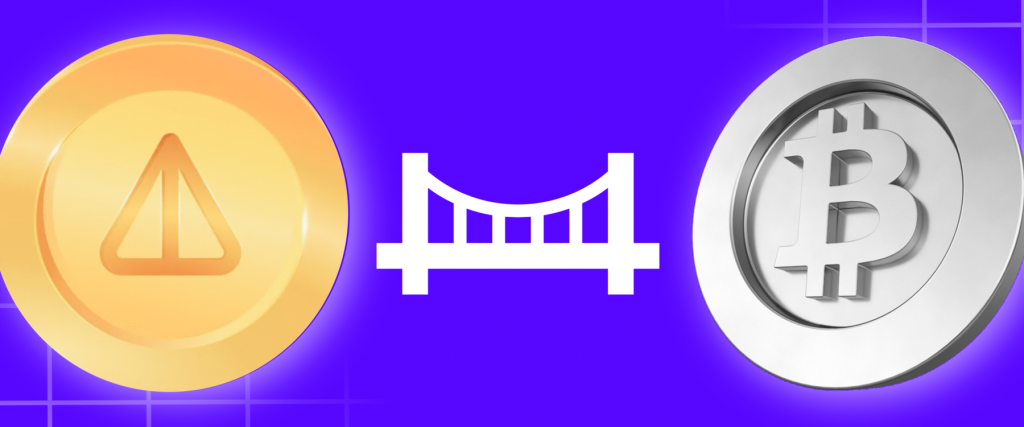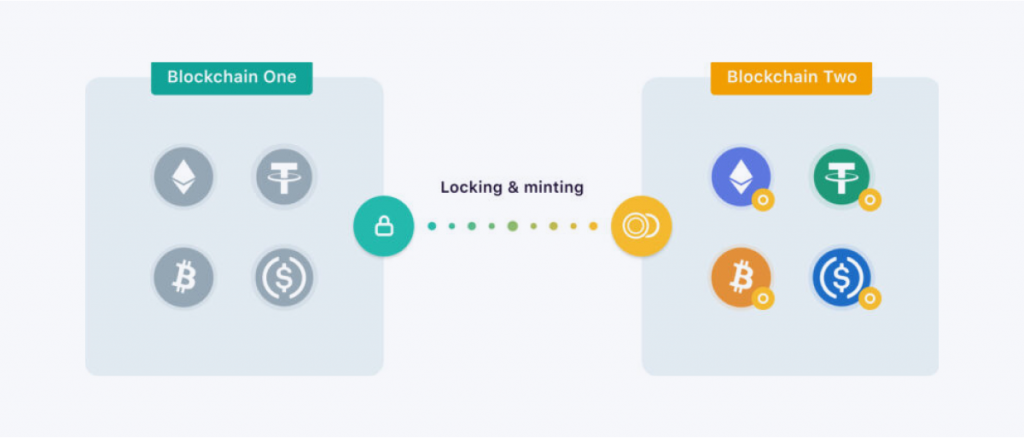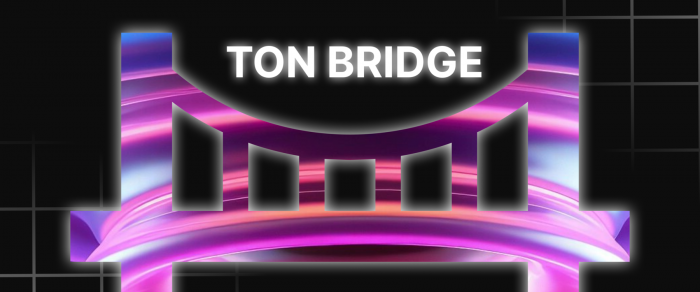Explore How to Break Blockchain Barriers with Ton Bridge
In modern reality, communications and connections have the most significant role in any sphere of activity. The need for seamless connectivity between diverse blockchains operating independently has become seriously critical. This is where cross-chain solutions like the Ton Bridge come into play.
Ton Bridge enables seamless asset transfer between the Telegram Open Network (TON) and other blockchains. Let’s explore Ton Bridge’s purpose, functionality, and the advantages it brings to the crypto ecosystem.
Key Takeaways:
- Ton Bridge bridges the TON Blockchain and other blockchains, fostering interoperability and asset movement.
- It utilizes a lock-and-mint mechanism, where deposited assets are locked on the source chain and minted as wrapped equivalents on the destination chain.
- Ton Bridge empowers users to explore DeFi opportunities, access a broader range of tokens, and benefit from TON’s scalability and security.
- The bridge fosters innovation within the TON ecosystem by enabling developers to build cross-chain applications.
The Open Network TON Ecosystem?
TON is a decentralized blockchain ecosystem initially developed by the team behind Telegram, the popular messaging app. TON aims to offer a scalable and efficient blockchain that supports fast transactions, decentralized applications (dApps), and a range of services within its ecosystem.
Fundamental components of the TON ecosystem are:
TON Blockchain
The core of the TON ecosystem is its blockchain, designed to process millions of transactions per second. It uses a unique multi-chain structure, where multiple blockchains (shards) work in parallel, allowing for high throughput and scalability.
TON dApps and Smart Contracts
The TON ecosystem supports dApps and smart contracts, enabling developers to create a wide range of services, from DeFi platforms to gaming and social media apps.
Governance
TON has a decentralized governance model where Toncoin holders can vote on proposals and changes to the network. This allows the community to have a say in the future development and direction of the ecosystem.
Toncoin (TON)

Toncoin is the native cryptocurrency of the TON ecosystem. It is used for transaction fees, staking, governance, and other activities within the network.
TON Wallets
These are digital wallets designed to store, send, and receive Toncoin. They can also interact with dApps and other services on the TON network. TON wallets are available as standalone applications or integrated within the Telegram app.
TON Bridge
The TON Bridge is a crucial component that allows interoperability between TON and other blockchain networks, such as Ethereum. This bridge enables users to transfer assets like USDT between TON and other blockchains, enhancing liquidity and expanding the ecosystem’s reach.
TON Services
The ecosystem includes various services built on the TON blockchain, such as decentralized exchanges (DEXs), lending platforms, and more. These services aim to leverage the scalability and efficiency of TON to provide fast, low-cost transactions.
TON DNS
TON DNS (Domain Name System) is a decentralized service that allows users to register and manage domain names on the TON network. This service aims to create a more user-friendly experience by enabling easy-to-remember names for addresses and services on the blockchain.
Understanding Ton Bridge: A Gateway Between Blockchains

The cryptocurrency landscape thrives on innovation, but one major hurdle remains the isolation of individual blockchains. Ton Bridge addresses this by establishing a secure and reliable connection between the TON Blockchain and other prominent blockchains. This empowers users to transfer their crypto assets seamlessly, unlocking new possibilities.
Imagine a scenario where you hold Bitcoin (BTC) on the Ethereum (ETH) network. Traditionally, transferring these assets directly wouldn’t be possible. Ton Bridge solves this by acting as an intermediary, facilitating the movement of assets between incompatible blockchains.
The Ton Bridge serves as a critical infrastructure in the TON ecosystem, allowing for interoperability and enhancing the utility of TON-based assets. The bridge leverages smart contracts to lock assets on one blockchain and mint equivalent tokens on another, ensuring that the total supply remains constant across networks.
How Does Ton Bridge Work: Crypto Bridging Explained
Crypto bridging is the process of transferring assets between different blockchain networks. This is essential in a multi-chain world where assets are spread across various platforms, each with its own set of rules and protocols. Ton Bridge plays a significant role in this space by providing a seamless and secure way to bridge assets to and from The Open Network.

The process of bridging assets via Ton Bridge is straightforward yet technically sophisticated. Ton Bridge employs a well-established mechanism known as a lock-and-mint system. Here’s a step-by-step breakdown of how it works:
1. Users initiate the transfer process by selecting the desired asset, destination chain, and amount on the bridge interface.
2. The chosen assets are locked in a smart contract on the source chain. This ensures the legitimacy of the transfer and prevents the creation of additional tokens without a corresponding deposit.
3. Once the assets are locked, an equivalent amount of wrapped tokens are minted on the destination chain. These wrapped tokens represent the locked assets and hold the same value.
4. Upon reaching the destination chain, users can unwrap their tokens through a designated bridge contract, receiving the original assets back.
The entire process is governed by smart contracts, which ensures that the bridge operates in a trustless and decentralized manner. The protocol also employs various security measures, such as multi-signature wallets and decentralized oracles, to prevent unauthorized transactions and ensure the integrity of the bridge.
Use Cases of Ton Bridge
TON Bridge opens up various use cases that enhance the functionality and utility of the TON ecosystem. The primary use case of the TON Bridge is to allow users to transfer assets, such as cryptocurrencies, from one blockchain to another. For example, users can bridge USDT from Ethereum to TON. This functionality gives users access to the liquidity and features of multiple blockchains, making it easier to move assets between networks without needing to rely on centralized exchanges.
TON Bridge facilitates the integration of TON with DeFi platforms on other blockchains. By bridging assets like ETH or USDT to the TON network, users can participate in TON-based DeFi services. This expands the range of financial services available to TON users, including lending, borrowing, staking, and yield farming, while benefiting from TON’s low transaction fees and high scalability.
Developers can build dApps on TON that interact with assets or services on other blockchains through the TON Bridge. This enables the creation of more versatile and feature-rich dApps that can utilize the strengths of multiple blockchains. For example, a dApp could leverage Ethereum’s smart contract capabilities while using TON for fast and low-cost transactions.
Traders can use the TON Bridge to capitalize on price differences for the same asset across different blockchains. By moving assets quickly and efficiently between networks, traders can take advantage of arbitrage opportunities, buying low on one blockchain and selling high on another.
The TON Bridge could be used to transfer NFTs between TON and other blockchain networks. This interoperability allows NFTs created on one blockchain to be traded or used in dApps on another, broadening the market and utility for NFTs.
Furthermore, Investors can bridge assets to TON to diversify their portfolios with assets native to different blockchains. By holding assets across multiple networks, users can spread risk and take advantage of the unique features and benefits offered by each blockchain.
Fast Fact:
On April 17, 2023, The TON Foundation, a non-profit association of developers and enthusiasts that exists to advance The Open Network (TON), announced the launch of a two-way bridge that enables the seamless transfer of ERC-20 tokens from Ethereum to natively wrapped fungible tokens (Jettons) on TON.
Benefits of Using Ton Bridge

The Ton Bridge offers several advantages that make it a valuable tool for crypto enthusiasts and developers:
Enhanced Interoperability
Ton Bridge breaks down the walls between blockchains, allowing users to leverage the unique features of different networks.
Increased Liquidity
By enabling asset movement, Ton Bridge contributes to increased liquidity within the TON ecosystem, attracting more users and developers.
Exploration of DeFi Opportunities
Users gain access to a broader range of DeFi applications and protocols across various blockchains, unlocking new ways to earn and grow their crypto portfolios.
Scalability and Security
TON offers superior scalability and security compared to some other blockchains. Ton Bridge allows users to benefit from these advantages while interacting with different networks.
Decentralisation
Unlike centralized exchanges that require users to trust a third party with their assets, the Ton Bridge operates fully decentralized. This means users retain complete control over their assets throughout the bridging process.
Cost-Effectiveness
Bridging assets through the Ton Bridge can be more cost-effective than traditional methods, especially when transferring assets between blockchains with high transaction fees like Ethereum. Using TON’s scalable and low-cost infrastructure, users can save on expenses and enjoy faster transaction times.
How to Bridge TON to ETH or BNB Smart Chain

One of the most common use cases for the Ton Bridge is bridging TON to Ethereum (ETH). Here’s a step-by-step guide on how to bridge TON to ETH:
1. First, you’ll need to connect your wallet to the Ton Bridge platform. Supported wallets include MetaMask for Ethereum and TON Wallet for TON. Ensure that you have sufficient TON in your wallet to cover the gas fees.
2. Once your wallet is connected, select the asset you wish to bridge from the available options. In this case, choose TON.
3. Enter the amount of TON you want to bridge and initiate the transaction. The Ton Bridge will lock your TON in a smart contract on the TON blockchain and mint an equivalent amount of wrapped TON (wTON) on the Ethereum network.
4. After confirming the transaction, you will receive wTON in your Ethereum wallet. This wrapped token can be used within the Ethereum DeFi ecosystem just like any other ERC-20 token.
If you want to convert your wTON back to TON, you can simply reverse the process by sending your wTON back to the bridge. The smart contract will burn the wTON and release the equivalent amount of TON on the TON blockchain.
The steps to bridge TON to BNB Smart Chain are practically the same: Connect your TON and BNB Smart Chain wallets to the TON Bridge interface. Next, select Toncoin (TON) as the asset you wish to bridge and choose BNB Smart Chain as the destination network. Specify the amount of TON to transfer and initiate the bridging process.
The TON Bridge will lock your TON on the TON network and mint an equivalent amount of wrapped TON on the BNB Smart Chain. Once the transaction is confirmed, you’ll have wrapped TON in your BNB Smart Chain wallet, which is ready for use within the BNB ecosystem.
Challenges and Future of Ton Bridge
While the Ton Bridge offers many benefits, it is not without its challenges. Recent developments, including the arrest of Telegram’s CEO, Pavel Durov, have brought new challenges to the forefront, impacting the future of Ton Bridge and the TON ecosystem as a whole.
One of the most significant challenges facing Ton Bridge is increasing regulatory scrutiny. Governments worldwide are tightening their stance on cryptocurrencies, particularly on projects with high levels of privacy and decentralization. The arrest of Pavel Durov underscores the growing tension between regulators and crypto innovators.
Security remains a paramount concern for any blockchain project, and Ton Bridge is no exception. The cross-chain nature of the bridge inherently introduces risks, as vulnerabilities in one connected blockchain could potentially compromise the entire network. Recent high-profile hacks in the DeFi space have heightened awareness around these issues, prompting the TON community to prioritize robust security measures. However, achieving this level of security while ensuring user convenience is a delicate balancing act.
For Ton Bridge to succeed, it must be widely adopted by both developers and users. However, the current user experience (UX) presents a barrier to entry for those unfamiliar with blockchain technology. The TON development team must address the challenge of simplifying the UX without compromising on the complexity of cross-chain operations. Additionally, the arrest of Durov may create uncertainty among potential users and developers, potentially slowing the adoption rate.
The blockchain space is fragmented, with multiple networks competing for dominance. This fragmentation poses a challenge for Ton Bridge, which relies on interoperability between chains. Ensuring seamless integration across various blockchain ecosystems while maintaining efficiency and low costs is daunting. The recent market volatility and uncertainty surrounding the TON project could further exacerbate this fragmentation, making it more difficult for Ton Bridge to achieve its goals.
Future Prospects of Ton Bridge
Despite the challenges, the future of Ton Bridge looks promising, particularly in the area of interoperability. As more blockchain networks recognize the importance of cross-chain communication, there will be increased collaboration between projects. With its robust infrastructure, Ton Bridge is well-positioned to become a leading solution in the interoperability space. The ongoing development of new features and partnerships will be crucial in solidifying its position.
The TON community is actively enhancing Ton Bridge’s security, incorporating advanced cryptographic techniques and decentralized validation mechanisms. These efforts aim to make the bridge more resilient to attacks, ensuring the safety of users’ assets. As these security improvements are implemented, Ton Bridge could become a benchmark for secure cross-chain transactions, attracting more users and developers.
In the absence of centralized leadership, the TON community has shown remarkable resilience and adaptability. The arrest of Durov, while a setback, has stimulated the community to take a more active role in the project’s development. This shift towards a more decentralized and community-driven approach could lead to innovative solutions and faster development cycles, benefiting Ton Bridge in the long run.
While regulatory challenges loom large, there is potential for legal and regulatory resolutions that could favor Ton Bridge and the broader TON ecosystem. If the project successfully navigates the regulatory landscape, it could become a compliant and trusted platform for cross-chain transactions. This would alleviate current challenges and open up new opportunities for growth and expansion.
Conclusion
The Ton Bridge faces many challenges, from regulatory pressures and security concerns to adoption hurdles and ecosystem fragmentation. However, the future is not without hope. With ongoing advancements in interoperability, enhanced security protocols, and a resilient community, Ton Bridge has the potential to overcome these obstacles and play a pivotal role in the future of blockchain technology.
The arrest of Telegram’s CEO may have cast a shadow over the project, but it has also sparked a renewed sense of purpose within the TON community, driving them to ensure the success of this innovative cross-chain solution.
FAQs:
What is Ton bridge crypto?
The Toncoin bridge allows you to transfer Toncoin between the TON Blockchain and the Ethereum blockchain and between the TON Blockchain and the BNB Smart Chain.
Is bridging crypto safe?
To protect against theft through crypto bridges, it is important to remain vigilant and follow best practices for security. When choosing a crypto bridge, research and ensure that the bridge has undergone thorough security audits.
How do you bridge USDT to ton?
To bridge USDT (Tether) to TON: Connect Your Wallet, Select USDT as the Asset, Initiate the Transaction, and receive wUSDT on TON.
What is a bridge Toncoin?
The Toncoin Bridge allows the transfer of TON Coins in a decentralized way between the TON Network, Ethereum Network, and Binance Smart Chain. Decentralized oracles manage the bridge.



